Nursing Care for Mrs. Gina Bacci's Post-Operative Wound Infection
VerifiedAdded on 2023/01/18
|10
|2904
|76
AI Summary
This essay discusses the case of Mrs. Gina Bacci, a patient with a post-operative wound infection. It explores the pathophysiology of wound infection, nursing priorities of care, and nursing care management. The essay provides insights into the assessment data, nursing diagnoses, and goals for implementing nursing interventions.
Contribute Materials
Your contribution can guide someone’s learning journey. Share your
documents today.
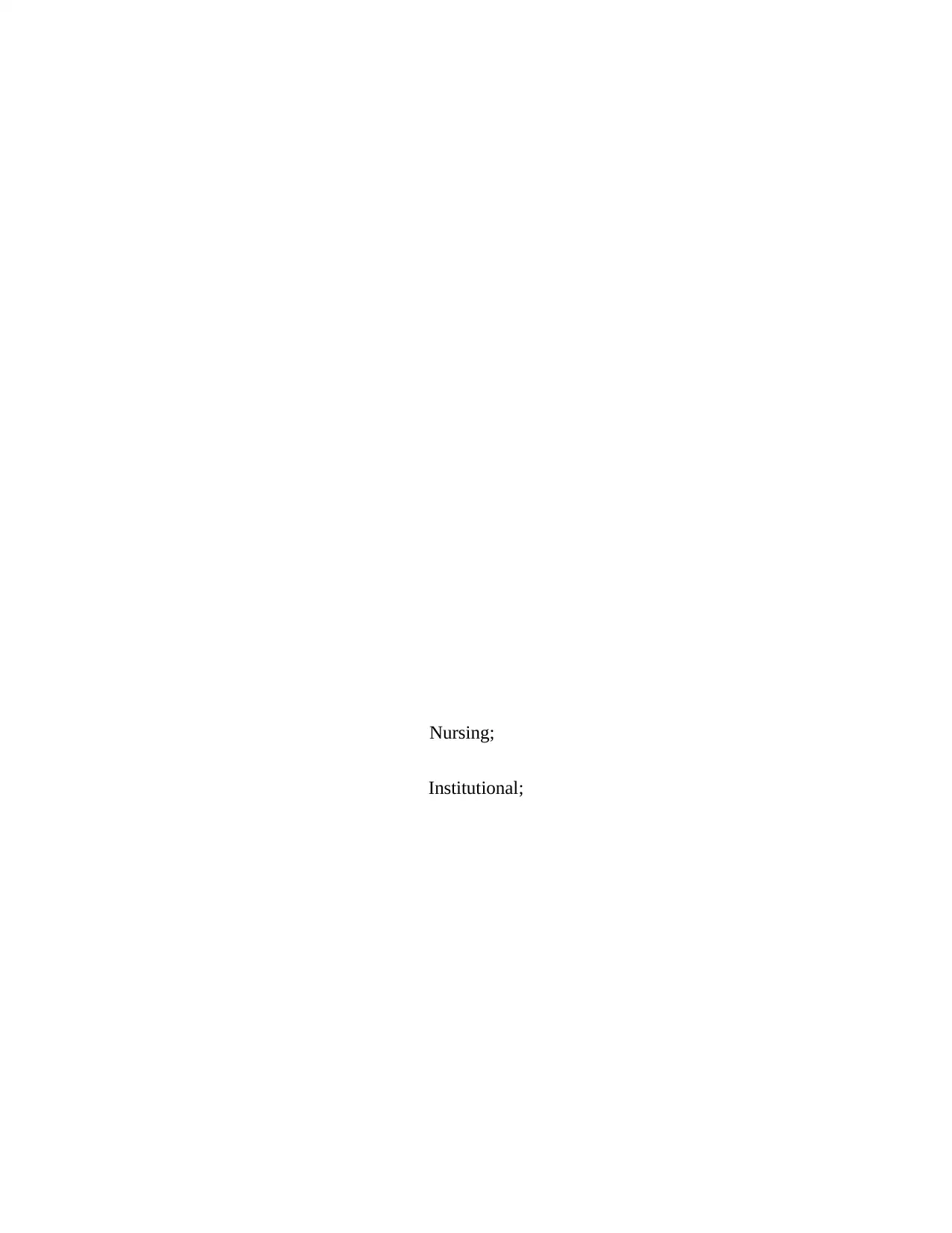
Nursing;
Institutional;
Institutional;
Secure Best Marks with AI Grader
Need help grading? Try our AI Grader for instant feedback on your assignments.
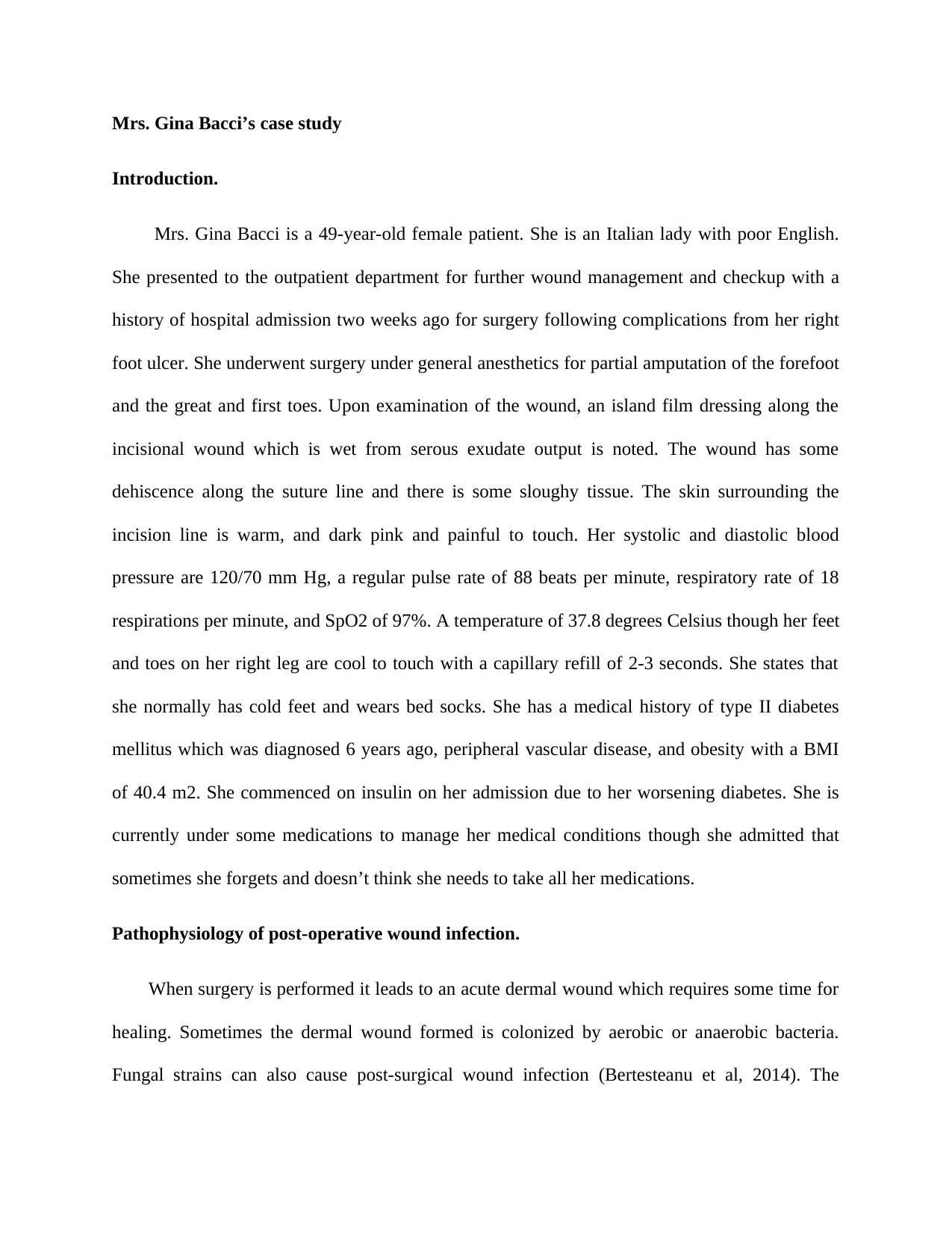
Mrs. Gina Bacci’s case study
Introduction.
Mrs. Gina Bacci is a 49-year-old female patient. She is an Italian lady with poor English.
She presented to the outpatient department for further wound management and checkup with a
history of hospital admission two weeks ago for surgery following complications from her right
foot ulcer. She underwent surgery under general anesthetics for partial amputation of the forefoot
and the great and first toes. Upon examination of the wound, an island film dressing along the
incisional wound which is wet from serous exudate output is noted. The wound has some
dehiscence along the suture line and there is some sloughy tissue. The skin surrounding the
incision line is warm, and dark pink and painful to touch. Her systolic and diastolic blood
pressure are 120/70 mm Hg, a regular pulse rate of 88 beats per minute, respiratory rate of 18
respirations per minute, and SpO2 of 97%. A temperature of 37.8 degrees Celsius though her feet
and toes on her right leg are cool to touch with a capillary refill of 2-3 seconds. She states that
she normally has cold feet and wears bed socks. She has a medical history of type II diabetes
mellitus which was diagnosed 6 years ago, peripheral vascular disease, and obesity with a BMI
of 40.4 m2. She commenced on insulin on her admission due to her worsening diabetes. She is
currently under some medications to manage her medical conditions though she admitted that
sometimes she forgets and doesn’t think she needs to take all her medications.
Pathophysiology of post-operative wound infection.
When surgery is performed it leads to an acute dermal wound which requires some time for
healing. Sometimes the dermal wound formed is colonized by aerobic or anaerobic bacteria.
Fungal strains can also cause post-surgical wound infection (Bertesteanu et al, 2014). The
Introduction.
Mrs. Gina Bacci is a 49-year-old female patient. She is an Italian lady with poor English.
She presented to the outpatient department for further wound management and checkup with a
history of hospital admission two weeks ago for surgery following complications from her right
foot ulcer. She underwent surgery under general anesthetics for partial amputation of the forefoot
and the great and first toes. Upon examination of the wound, an island film dressing along the
incisional wound which is wet from serous exudate output is noted. The wound has some
dehiscence along the suture line and there is some sloughy tissue. The skin surrounding the
incision line is warm, and dark pink and painful to touch. Her systolic and diastolic blood
pressure are 120/70 mm Hg, a regular pulse rate of 88 beats per minute, respiratory rate of 18
respirations per minute, and SpO2 of 97%. A temperature of 37.8 degrees Celsius though her feet
and toes on her right leg are cool to touch with a capillary refill of 2-3 seconds. She states that
she normally has cold feet and wears bed socks. She has a medical history of type II diabetes
mellitus which was diagnosed 6 years ago, peripheral vascular disease, and obesity with a BMI
of 40.4 m2. She commenced on insulin on her admission due to her worsening diabetes. She is
currently under some medications to manage her medical conditions though she admitted that
sometimes she forgets and doesn’t think she needs to take all her medications.
Pathophysiology of post-operative wound infection.
When surgery is performed it leads to an acute dermal wound which requires some time for
healing. Sometimes the dermal wound formed is colonized by aerobic or anaerobic bacteria.
Fungal strains can also cause post-surgical wound infection (Bertesteanu et al, 2014). The

bacteria causing the infections can originate from the skin that surrounds the incision site, or
from the external environment. They, therefore, form microbial communities called biofilms.
This mostly occurs in the failure of observing aseptic techniques during wound care and
management. Some of the aseptic techniques including thorough hand washing, wearing gloves
and maintaining a clean working area (Megeus et al. 2015) When we talking of pathophysiology
of the wound infection, we therefore simply mean the role of the polymicrobial film in delaying
repair processes and the outcome of it. Wound infection normally occurs when the virulence
microorganisms including the bacteria and the fungi overwhelm the body natural body defense
mechanism (Weiss & Schaible 2015). The infection will now, therefore, trigger the body's
immune system to respond which will lead to inflammation and tissue damage and slowing the
healing process. A response of the immune system results mainly into phagocytosis and
correlation. Phagocytosis is a process by which particulate matter is ingested into specialized
cells, degraded and the harmless debris or the products are expelled into the stroma. The
principles cells involved in the processes are the neutrophils and the macrophages. The immune
system is composed of the complement system that eradicates the microbes when activated
(Parham, 2014). There are three end results of the complement system, however, the major one is
the inflammation to attract additional phagocytes to kill the foreign particles including the
microbes. The end result of the system is also changing in the anatomy of the incision site thus
the pathophysiology.
Virulence microorganisms invade the body through the incision site and injure the viable
tissues surrounding the incision site. The damaged injured cells, therefore, produce chemicals in
response including histamine, bradykinin, and prostaglandins (Widgerow & Kalaria, 2012). The
released chemicals lead to inflammation by causing blood vessels to leak blood fluids into the
from the external environment. They, therefore, form microbial communities called biofilms.
This mostly occurs in the failure of observing aseptic techniques during wound care and
management. Some of the aseptic techniques including thorough hand washing, wearing gloves
and maintaining a clean working area (Megeus et al. 2015) When we talking of pathophysiology
of the wound infection, we therefore simply mean the role of the polymicrobial film in delaying
repair processes and the outcome of it. Wound infection normally occurs when the virulence
microorganisms including the bacteria and the fungi overwhelm the body natural body defense
mechanism (Weiss & Schaible 2015). The infection will now, therefore, trigger the body's
immune system to respond which will lead to inflammation and tissue damage and slowing the
healing process. A response of the immune system results mainly into phagocytosis and
correlation. Phagocytosis is a process by which particulate matter is ingested into specialized
cells, degraded and the harmless debris or the products are expelled into the stroma. The
principles cells involved in the processes are the neutrophils and the macrophages. The immune
system is composed of the complement system that eradicates the microbes when activated
(Parham, 2014). There are three end results of the complement system, however, the major one is
the inflammation to attract additional phagocytes to kill the foreign particles including the
microbes. The end result of the system is also changing in the anatomy of the incision site thus
the pathophysiology.
Virulence microorganisms invade the body through the incision site and injure the viable
tissues surrounding the incision site. The damaged injured cells, therefore, produce chemicals in
response including histamine, bradykinin, and prostaglandins (Widgerow & Kalaria, 2012). The
released chemicals lead to inflammation by causing blood vessels to leak blood fluids into the
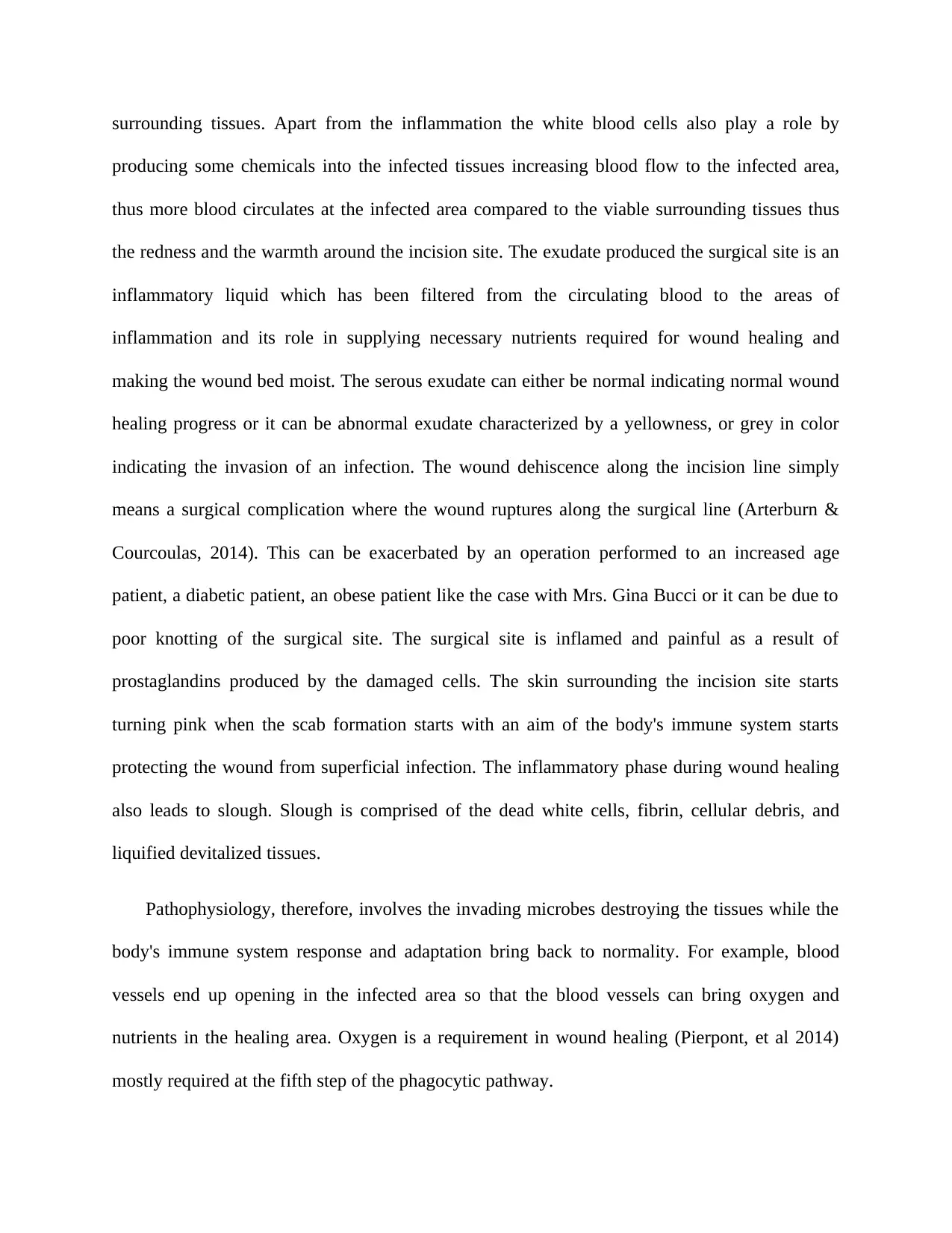
surrounding tissues. Apart from the inflammation the white blood cells also play a role by
producing some chemicals into the infected tissues increasing blood flow to the infected area,
thus more blood circulates at the infected area compared to the viable surrounding tissues thus
the redness and the warmth around the incision site. The exudate produced the surgical site is an
inflammatory liquid which has been filtered from the circulating blood to the areas of
inflammation and its role in supplying necessary nutrients required for wound healing and
making the wound bed moist. The serous exudate can either be normal indicating normal wound
healing progress or it can be abnormal exudate characterized by a yellowness, or grey in color
indicating the invasion of an infection. The wound dehiscence along the incision line simply
means a surgical complication where the wound ruptures along the surgical line (Arterburn &
Courcoulas, 2014). This can be exacerbated by an operation performed to an increased age
patient, a diabetic patient, an obese patient like the case with Mrs. Gina Bucci or it can be due to
poor knotting of the surgical site. The surgical site is inflamed and painful as a result of
prostaglandins produced by the damaged cells. The skin surrounding the incision site starts
turning pink when the scab formation starts with an aim of the body's immune system starts
protecting the wound from superficial infection. The inflammatory phase during wound healing
also leads to slough. Slough is comprised of the dead white cells, fibrin, cellular debris, and
liquified devitalized tissues.
Pathophysiology, therefore, involves the invading microbes destroying the tissues while the
body's immune system response and adaptation bring back to normality. For example, blood
vessels end up opening in the infected area so that the blood vessels can bring oxygen and
nutrients in the healing area. Oxygen is a requirement in wound healing (Pierpont, et al 2014)
mostly required at the fifth step of the phagocytic pathway.
producing some chemicals into the infected tissues increasing blood flow to the infected area,
thus more blood circulates at the infected area compared to the viable surrounding tissues thus
the redness and the warmth around the incision site. The exudate produced the surgical site is an
inflammatory liquid which has been filtered from the circulating blood to the areas of
inflammation and its role in supplying necessary nutrients required for wound healing and
making the wound bed moist. The serous exudate can either be normal indicating normal wound
healing progress or it can be abnormal exudate characterized by a yellowness, or grey in color
indicating the invasion of an infection. The wound dehiscence along the incision line simply
means a surgical complication where the wound ruptures along the surgical line (Arterburn &
Courcoulas, 2014). This can be exacerbated by an operation performed to an increased age
patient, a diabetic patient, an obese patient like the case with Mrs. Gina Bucci or it can be due to
poor knotting of the surgical site. The surgical site is inflamed and painful as a result of
prostaglandins produced by the damaged cells. The skin surrounding the incision site starts
turning pink when the scab formation starts with an aim of the body's immune system starts
protecting the wound from superficial infection. The inflammatory phase during wound healing
also leads to slough. Slough is comprised of the dead white cells, fibrin, cellular debris, and
liquified devitalized tissues.
Pathophysiology, therefore, involves the invading microbes destroying the tissues while the
body's immune system response and adaptation bring back to normality. For example, blood
vessels end up opening in the infected area so that the blood vessels can bring oxygen and
nutrients in the healing area. Oxygen is a requirement in wound healing (Pierpont, et al 2014)
mostly required at the fifth step of the phagocytic pathway.
Secure Best Marks with AI Grader
Need help grading? Try our AI Grader for instant feedback on your assignments.
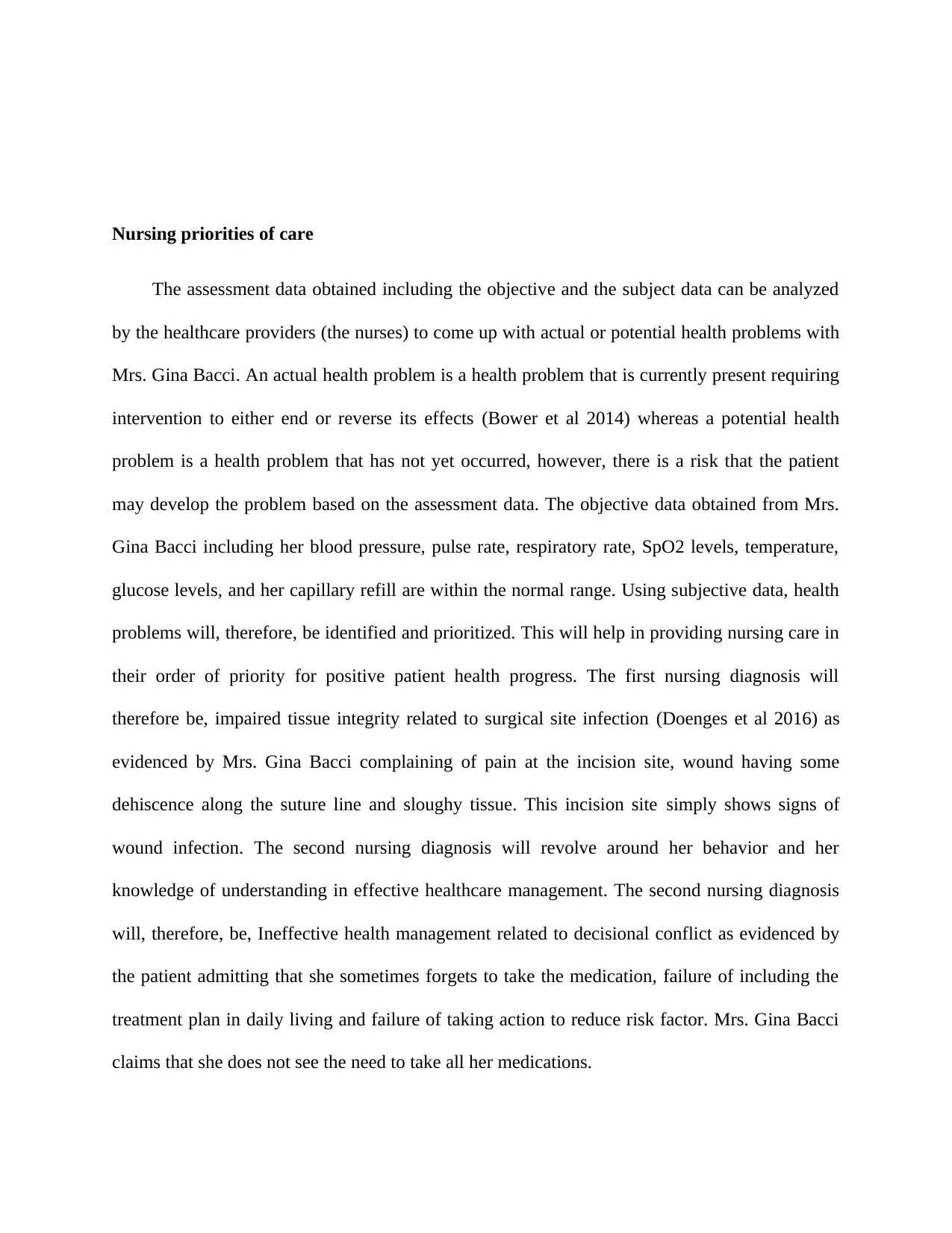
Nursing priorities of care
The assessment data obtained including the objective and the subject data can be analyzed
by the healthcare providers (the nurses) to come up with actual or potential health problems with
Mrs. Gina Bacci. An actual health problem is a health problem that is currently present requiring
intervention to either end or reverse its effects (Bower et al 2014) whereas a potential health
problem is a health problem that has not yet occurred, however, there is a risk that the patient
may develop the problem based on the assessment data. The objective data obtained from Mrs.
Gina Bacci including her blood pressure, pulse rate, respiratory rate, SpO2 levels, temperature,
glucose levels, and her capillary refill are within the normal range. Using subjective data, health
problems will, therefore, be identified and prioritized. This will help in providing nursing care in
their order of priority for positive patient health progress. The first nursing diagnosis will
therefore be, impaired tissue integrity related to surgical site infection (Doenges et al 2016) as
evidenced by Mrs. Gina Bacci complaining of pain at the incision site, wound having some
dehiscence along the suture line and sloughy tissue. This incision site simply shows signs of
wound infection. The second nursing diagnosis will revolve around her behavior and her
knowledge of understanding in effective healthcare management. The second nursing diagnosis
will, therefore, be, Ineffective health management related to decisional conflict as evidenced by
the patient admitting that she sometimes forgets to take the medication, failure of including the
treatment plan in daily living and failure of taking action to reduce risk factor. Mrs. Gina Bacci
claims that she does not see the need to take all her medications.
The assessment data obtained including the objective and the subject data can be analyzed
by the healthcare providers (the nurses) to come up with actual or potential health problems with
Mrs. Gina Bacci. An actual health problem is a health problem that is currently present requiring
intervention to either end or reverse its effects (Bower et al 2014) whereas a potential health
problem is a health problem that has not yet occurred, however, there is a risk that the patient
may develop the problem based on the assessment data. The objective data obtained from Mrs.
Gina Bacci including her blood pressure, pulse rate, respiratory rate, SpO2 levels, temperature,
glucose levels, and her capillary refill are within the normal range. Using subjective data, health
problems will, therefore, be identified and prioritized. This will help in providing nursing care in
their order of priority for positive patient health progress. The first nursing diagnosis will
therefore be, impaired tissue integrity related to surgical site infection (Doenges et al 2016) as
evidenced by Mrs. Gina Bacci complaining of pain at the incision site, wound having some
dehiscence along the suture line and sloughy tissue. This incision site simply shows signs of
wound infection. The second nursing diagnosis will revolve around her behavior and her
knowledge of understanding in effective healthcare management. The second nursing diagnosis
will, therefore, be, Ineffective health management related to decisional conflict as evidenced by
the patient admitting that she sometimes forgets to take the medication, failure of including the
treatment plan in daily living and failure of taking action to reduce risk factor. Mrs. Gina Bacci
claims that she does not see the need to take all her medications.
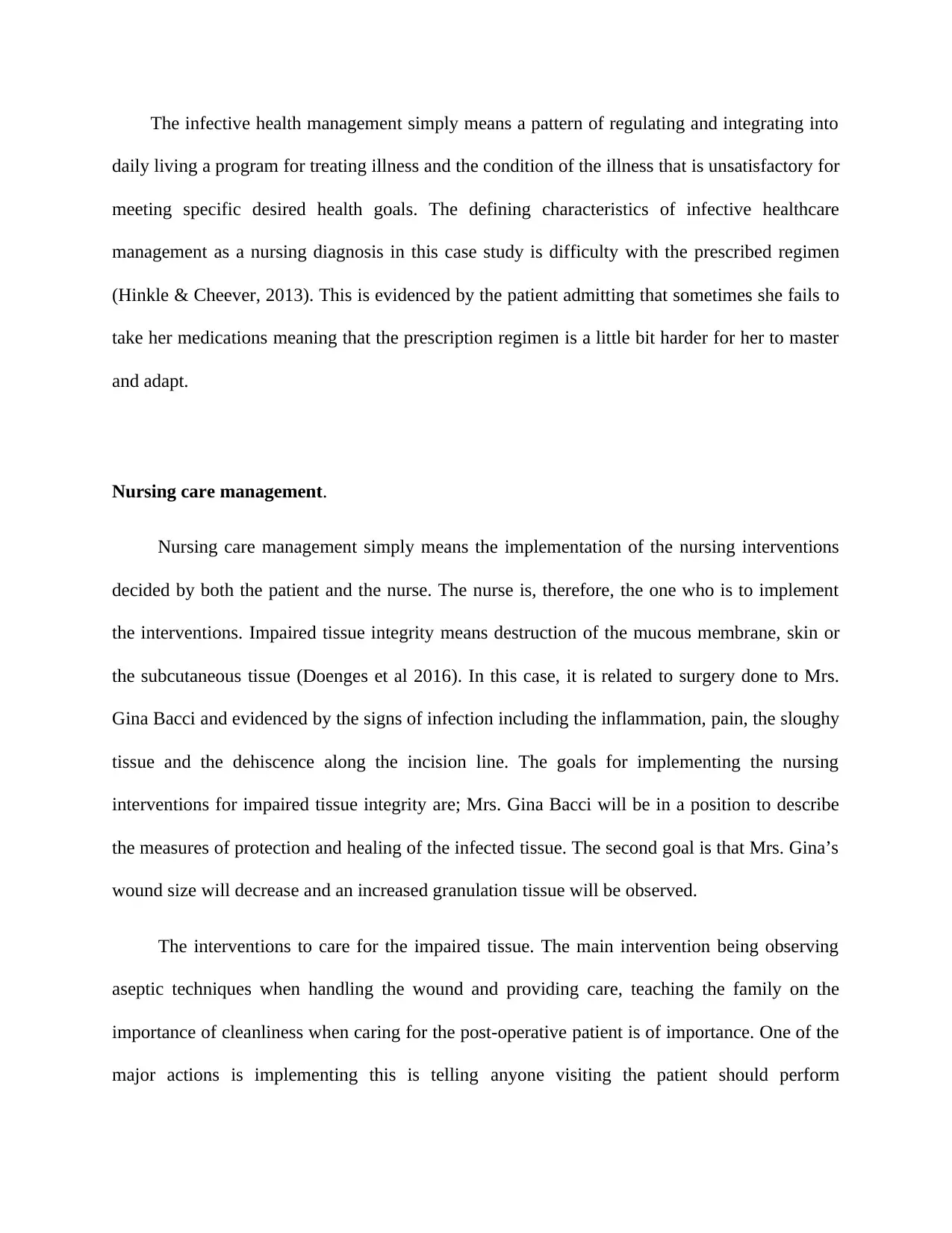
The infective health management simply means a pattern of regulating and integrating into
daily living a program for treating illness and the condition of the illness that is unsatisfactory for
meeting specific desired health goals. The defining characteristics of infective healthcare
management as a nursing diagnosis in this case study is difficulty with the prescribed regimen
(Hinkle & Cheever, 2013). This is evidenced by the patient admitting that sometimes she fails to
take her medications meaning that the prescription regimen is a little bit harder for her to master
and adapt.
Nursing care management.
Nursing care management simply means the implementation of the nursing interventions
decided by both the patient and the nurse. The nurse is, therefore, the one who is to implement
the interventions. Impaired tissue integrity means destruction of the mucous membrane, skin or
the subcutaneous tissue (Doenges et al 2016). In this case, it is related to surgery done to Mrs.
Gina Bacci and evidenced by the signs of infection including the inflammation, pain, the sloughy
tissue and the dehiscence along the incision line. The goals for implementing the nursing
interventions for impaired tissue integrity are; Mrs. Gina Bacci will be in a position to describe
the measures of protection and healing of the infected tissue. The second goal is that Mrs. Gina’s
wound size will decrease and an increased granulation tissue will be observed.
The interventions to care for the impaired tissue. The main intervention being observing
aseptic techniques when handling the wound and providing care, teaching the family on the
importance of cleanliness when caring for the post-operative patient is of importance. One of the
major actions is implementing this is telling anyone visiting the patient should perform
daily living a program for treating illness and the condition of the illness that is unsatisfactory for
meeting specific desired health goals. The defining characteristics of infective healthcare
management as a nursing diagnosis in this case study is difficulty with the prescribed regimen
(Hinkle & Cheever, 2013). This is evidenced by the patient admitting that sometimes she fails to
take her medications meaning that the prescription regimen is a little bit harder for her to master
and adapt.
Nursing care management.
Nursing care management simply means the implementation of the nursing interventions
decided by both the patient and the nurse. The nurse is, therefore, the one who is to implement
the interventions. Impaired tissue integrity means destruction of the mucous membrane, skin or
the subcutaneous tissue (Doenges et al 2016). In this case, it is related to surgery done to Mrs.
Gina Bacci and evidenced by the signs of infection including the inflammation, pain, the sloughy
tissue and the dehiscence along the incision line. The goals for implementing the nursing
interventions for impaired tissue integrity are; Mrs. Gina Bacci will be in a position to describe
the measures of protection and healing of the infected tissue. The second goal is that Mrs. Gina’s
wound size will decrease and an increased granulation tissue will be observed.
The interventions to care for the impaired tissue. The main intervention being observing
aseptic techniques when handling the wound and providing care, teaching the family on the
importance of cleanliness when caring for the post-operative patient is of importance. One of the
major actions is implementing this is telling anyone visiting the patient should perform
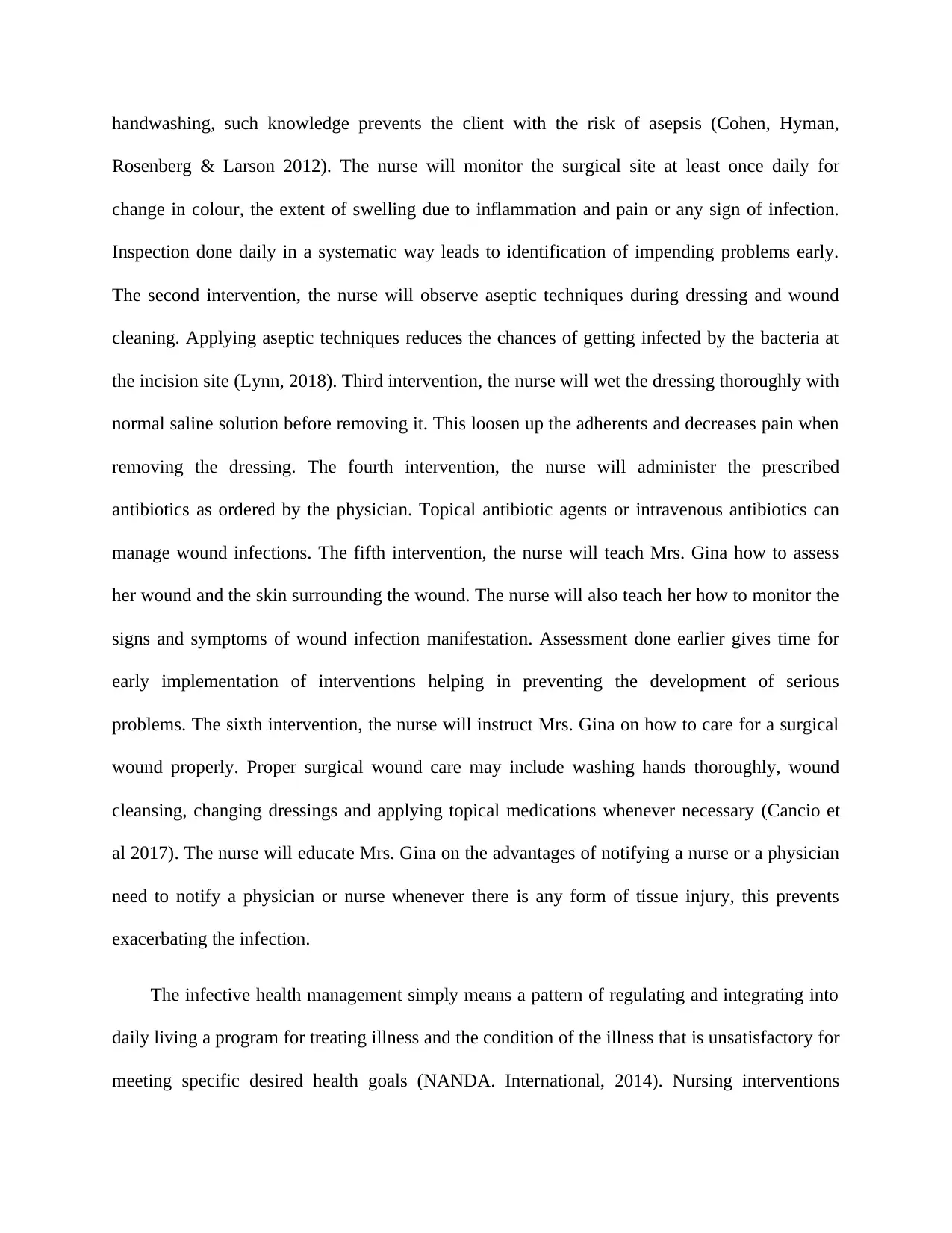
handwashing, such knowledge prevents the client with the risk of asepsis (Cohen, Hyman,
Rosenberg & Larson 2012). The nurse will monitor the surgical site at least once daily for
change in colour, the extent of swelling due to inflammation and pain or any sign of infection.
Inspection done daily in a systematic way leads to identification of impending problems early.
The second intervention, the nurse will observe aseptic techniques during dressing and wound
cleaning. Applying aseptic techniques reduces the chances of getting infected by the bacteria at
the incision site (Lynn, 2018). Third intervention, the nurse will wet the dressing thoroughly with
normal saline solution before removing it. This loosen up the adherents and decreases pain when
removing the dressing. The fourth intervention, the nurse will administer the prescribed
antibiotics as ordered by the physician. Topical antibiotic agents or intravenous antibiotics can
manage wound infections. The fifth intervention, the nurse will teach Mrs. Gina how to assess
her wound and the skin surrounding the wound. The nurse will also teach her how to monitor the
signs and symptoms of wound infection manifestation. Assessment done earlier gives time for
early implementation of interventions helping in preventing the development of serious
problems. The sixth intervention, the nurse will instruct Mrs. Gina on how to care for a surgical
wound properly. Proper surgical wound care may include washing hands thoroughly, wound
cleansing, changing dressings and applying topical medications whenever necessary (Cancio et
al 2017). The nurse will educate Mrs. Gina on the advantages of notifying a nurse or a physician
need to notify a physician or nurse whenever there is any form of tissue injury, this prevents
exacerbating the infection.
The infective health management simply means a pattern of regulating and integrating into
daily living a program for treating illness and the condition of the illness that is unsatisfactory for
meeting specific desired health goals (NANDA. International, 2014). Nursing interventions
Rosenberg & Larson 2012). The nurse will monitor the surgical site at least once daily for
change in colour, the extent of swelling due to inflammation and pain or any sign of infection.
Inspection done daily in a systematic way leads to identification of impending problems early.
The second intervention, the nurse will observe aseptic techniques during dressing and wound
cleaning. Applying aseptic techniques reduces the chances of getting infected by the bacteria at
the incision site (Lynn, 2018). Third intervention, the nurse will wet the dressing thoroughly with
normal saline solution before removing it. This loosen up the adherents and decreases pain when
removing the dressing. The fourth intervention, the nurse will administer the prescribed
antibiotics as ordered by the physician. Topical antibiotic agents or intravenous antibiotics can
manage wound infections. The fifth intervention, the nurse will teach Mrs. Gina how to assess
her wound and the skin surrounding the wound. The nurse will also teach her how to monitor the
signs and symptoms of wound infection manifestation. Assessment done earlier gives time for
early implementation of interventions helping in preventing the development of serious
problems. The sixth intervention, the nurse will instruct Mrs. Gina on how to care for a surgical
wound properly. Proper surgical wound care may include washing hands thoroughly, wound
cleansing, changing dressings and applying topical medications whenever necessary (Cancio et
al 2017). The nurse will educate Mrs. Gina on the advantages of notifying a nurse or a physician
need to notify a physician or nurse whenever there is any form of tissue injury, this prevents
exacerbating the infection.
The infective health management simply means a pattern of regulating and integrating into
daily living a program for treating illness and the condition of the illness that is unsatisfactory for
meeting specific desired health goals (NANDA. International, 2014). Nursing interventions
Paraphrase This Document
Need a fresh take? Get an instant paraphrase of this document with our AI Paraphraser
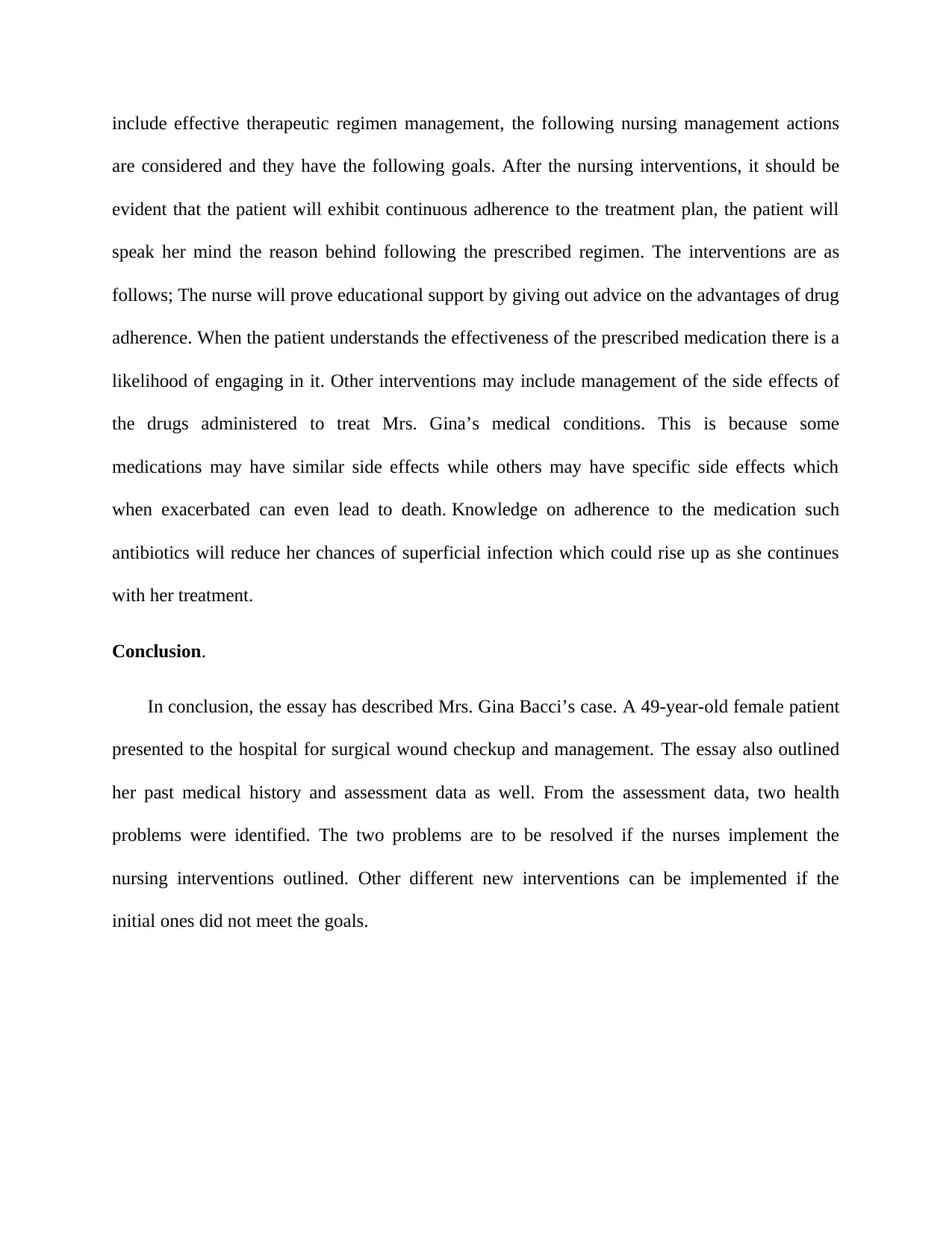
include effective therapeutic regimen management, the following nursing management actions
are considered and they have the following goals. After the nursing interventions, it should be
evident that the patient will exhibit continuous adherence to the treatment plan, the patient will
speak her mind the reason behind following the prescribed regimen. The interventions are as
follows; The nurse will prove educational support by giving out advice on the advantages of drug
adherence. When the patient understands the effectiveness of the prescribed medication there is a
likelihood of engaging in it. Other interventions may include management of the side effects of
the drugs administered to treat Mrs. Gina’s medical conditions. This is because some
medications may have similar side effects while others may have specific side effects which
when exacerbated can even lead to death. Knowledge on adherence to the medication such
antibiotics will reduce her chances of superficial infection which could rise up as she continues
with her treatment.
Conclusion.
In conclusion, the essay has described Mrs. Gina Bacci’s case. A 49-year-old female patient
presented to the hospital for surgical wound checkup and management. The essay also outlined
her past medical history and assessment data as well. From the assessment data, two health
problems were identified. The two problems are to be resolved if the nurses implement the
nursing interventions outlined. Other different new interventions can be implemented if the
initial ones did not meet the goals.
are considered and they have the following goals. After the nursing interventions, it should be
evident that the patient will exhibit continuous adherence to the treatment plan, the patient will
speak her mind the reason behind following the prescribed regimen. The interventions are as
follows; The nurse will prove educational support by giving out advice on the advantages of drug
adherence. When the patient understands the effectiveness of the prescribed medication there is a
likelihood of engaging in it. Other interventions may include management of the side effects of
the drugs administered to treat Mrs. Gina’s medical conditions. This is because some
medications may have similar side effects while others may have specific side effects which
when exacerbated can even lead to death. Knowledge on adherence to the medication such
antibiotics will reduce her chances of superficial infection which could rise up as she continues
with her treatment.
Conclusion.
In conclusion, the essay has described Mrs. Gina Bacci’s case. A 49-year-old female patient
presented to the hospital for surgical wound checkup and management. The essay also outlined
her past medical history and assessment data as well. From the assessment data, two health
problems were identified. The two problems are to be resolved if the nurses implement the
nursing interventions outlined. Other different new interventions can be implemented if the
initial ones did not meet the goals.

References.
Arterburn, D. E., & Courcoulas, A. P. (2014). Bariatric surgery for obesity and metabolic
conditions in adults. bmj, 349, g3961
Bertesteanu, S., Triaridis, S., Stankovic, M., Lazar, V., Chifiriuc, M. C., Vlad, M., & Grigore, R.
(2014). Polymicrobial wound infections: pathophysiology and current therapeutic
approaches. International journal of pharmaceutics, 463(2), 119-126.
Bower, P., Brueton, V., Gamble, C., Treweek, S., Smith, C.T., Young, B. and Williamson, P.,
(2014). Interventions to improve recruitment and retention in clinical trials: a survey and
workshop to assess current practice and future priorities. Trials, 15(1), p.399
Cancio, L.C., Barillo, D.J., Kearns, R.D., Holmes IV, J.H., Conlon, K.M., Matherly, A.F.,
Cairns, B.A., Hickerson, W.L. and Palmieri, T., 2017. Guidelines for burn care under
austere conditions: surgical and nonsurgical wound management. Journal of Burn Care
& Research, 38(4), pp.203-214.
Cohen, B., Hyman, S., Rosenberg, L., & Larson, E. (2012). Frequency of patient contact with
health care personnel and visitors: implications for infection prevention. The Joint
Commission Journal on Quality and Patient Safety, 38(12), 560-565.
Doenges, M.E., Moorhouse, M.F. and Murr, A.C., 2016. Nurse's pocket guide: Diagnoses,
prioritized interventions, and rationales. FA Davis.
Hinkle, J. L., & Cheever, K. H. (2013). Study Guide for Brunner & Suddarth's Textbook of
Medical-surgical Nursing. Lippincott Williams & Wilkins
Arterburn, D. E., & Courcoulas, A. P. (2014). Bariatric surgery for obesity and metabolic
conditions in adults. bmj, 349, g3961
Bertesteanu, S., Triaridis, S., Stankovic, M., Lazar, V., Chifiriuc, M. C., Vlad, M., & Grigore, R.
(2014). Polymicrobial wound infections: pathophysiology and current therapeutic
approaches. International journal of pharmaceutics, 463(2), 119-126.
Bower, P., Brueton, V., Gamble, C., Treweek, S., Smith, C.T., Young, B. and Williamson, P.,
(2014). Interventions to improve recruitment and retention in clinical trials: a survey and
workshop to assess current practice and future priorities. Trials, 15(1), p.399
Cancio, L.C., Barillo, D.J., Kearns, R.D., Holmes IV, J.H., Conlon, K.M., Matherly, A.F.,
Cairns, B.A., Hickerson, W.L. and Palmieri, T., 2017. Guidelines for burn care under
austere conditions: surgical and nonsurgical wound management. Journal of Burn Care
& Research, 38(4), pp.203-214.
Cohen, B., Hyman, S., Rosenberg, L., & Larson, E. (2012). Frequency of patient contact with
health care personnel and visitors: implications for infection prevention. The Joint
Commission Journal on Quality and Patient Safety, 38(12), 560-565.
Doenges, M.E., Moorhouse, M.F. and Murr, A.C., 2016. Nurse's pocket guide: Diagnoses,
prioritized interventions, and rationales. FA Davis.
Hinkle, J. L., & Cheever, K. H. (2013). Study Guide for Brunner & Suddarth's Textbook of
Medical-surgical Nursing. Lippincott Williams & Wilkins
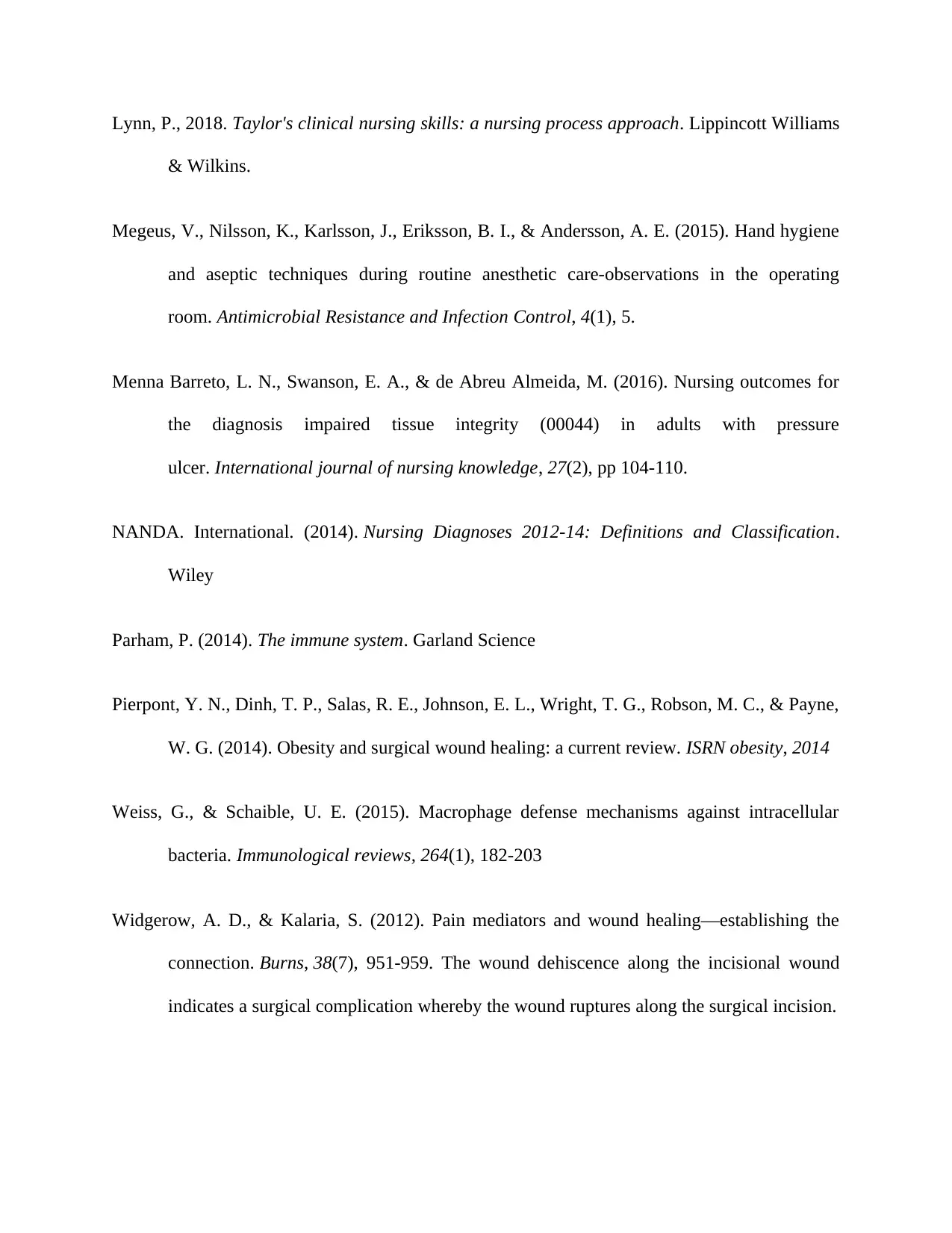
Lynn, P., 2018. Taylor's clinical nursing skills: a nursing process approach. Lippincott Williams
& Wilkins.
Megeus, V., Nilsson, K., Karlsson, J., Eriksson, B. I., & Andersson, A. E. (2015). Hand hygiene
and aseptic techniques during routine anesthetic care-observations in the operating
room. Antimicrobial Resistance and Infection Control, 4(1), 5.
Menna Barreto, L. N., Swanson, E. A., & de Abreu Almeida, M. (2016). Nursing outcomes for
the diagnosis impaired tissue integrity (00044) in adults with pressure
ulcer. International journal of nursing knowledge, 27(2), pp 104-110.
NANDA. International. (2014). Nursing Diagnoses 2012-14: Definitions and Classification.
Wiley
Parham, P. (2014). The immune system. Garland Science
Pierpont, Y. N., Dinh, T. P., Salas, R. E., Johnson, E. L., Wright, T. G., Robson, M. C., & Payne,
W. G. (2014). Obesity and surgical wound healing: a current review. ISRN obesity, 2014
Weiss, G., & Schaible, U. E. (2015). Macrophage defense mechanisms against intracellular
bacteria. Immunological reviews, 264(1), 182-203
Widgerow, A. D., & Kalaria, S. (2012). Pain mediators and wound healing—establishing the
connection. Burns, 38(7), 951-959. The wound dehiscence along the incisional wound
indicates a surgical complication whereby the wound ruptures along the surgical incision.
& Wilkins.
Megeus, V., Nilsson, K., Karlsson, J., Eriksson, B. I., & Andersson, A. E. (2015). Hand hygiene
and aseptic techniques during routine anesthetic care-observations in the operating
room. Antimicrobial Resistance and Infection Control, 4(1), 5.
Menna Barreto, L. N., Swanson, E. A., & de Abreu Almeida, M. (2016). Nursing outcomes for
the diagnosis impaired tissue integrity (00044) in adults with pressure
ulcer. International journal of nursing knowledge, 27(2), pp 104-110.
NANDA. International. (2014). Nursing Diagnoses 2012-14: Definitions and Classification.
Wiley
Parham, P. (2014). The immune system. Garland Science
Pierpont, Y. N., Dinh, T. P., Salas, R. E., Johnson, E. L., Wright, T. G., Robson, M. C., & Payne,
W. G. (2014). Obesity and surgical wound healing: a current review. ISRN obesity, 2014
Weiss, G., & Schaible, U. E. (2015). Macrophage defense mechanisms against intracellular
bacteria. Immunological reviews, 264(1), 182-203
Widgerow, A. D., & Kalaria, S. (2012). Pain mediators and wound healing—establishing the
connection. Burns, 38(7), 951-959. The wound dehiscence along the incisional wound
indicates a surgical complication whereby the wound ruptures along the surgical incision.
1 out of 10
Related Documents
Your All-in-One AI-Powered Toolkit for Academic Success.
+13062052269
info@desklib.com
Available 24*7 on WhatsApp / Email
![[object Object]](/_next/static/media/star-bottom.7253800d.svg)
Unlock your academic potential
© 2024 | Zucol Services PVT LTD | All rights reserved.





